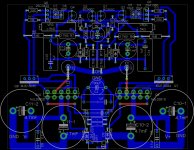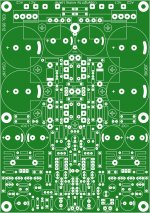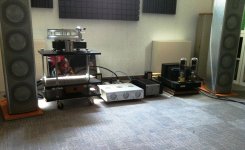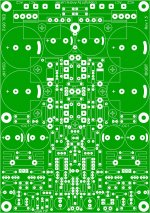SOUND-Rays has given the best contemporary overview of this tricky question I have yet read. Thank you.
What does of course play a very big part is that an old guy like me cannot possibly hear as much information as can the normal young person. Our hearing does shut-down as we age - even if we have not damaged our hearing earlier in life.
And there is always a vested interest to consider. An old guy like me is likely to have a considerable number of albums collected over, in my case, more than 50 years. Although I have quite a few CDs, my main investment in music is in vinyl. (Also, many of the CDs are 10+ years old and were hurriedly remastered from analogue, too often by second rate sound engineers using very poor equipment in unsuitable mixing rooms in office blocks. I was in one of these facilities at the time. Quad 303 amps, Spendor domestic speakers, no sound proofing from external noise....2 miles from Heathrow International Airport..... and on the flight path!!!!!!).
Not many people can afford to go through their music library and replace favourite recordings with modern highest quality digital discs...even if they can be found, the interpretation of the music is often such that it looses its emotional attraction! To a greater or lesser degree, much of the music (classical) is now usually interpreted by conductors and soloists differently than was normal in the past, although there has always been a wide variety of choice. I would bet that Studio recordings - if it were possible - recorded in say Abbey Road with its 'old' acoustics will always sound very much different to recordings made (even if on the same equipment) in a 'modern' studio such as those designed by modern acoustic designers such as Sam Toyashima.
Joachim is very correct in emphasising the need to obtain truly clean and flat records - and to keep them in that condition.
Added to the balance between vinyl and silver discs as being a decision maker, we have to add the cost of a really good CD system...at a time when the CD medium is very possibly at the end of its life span!
As it is impossible to be truly objective, and as so many personal 'sitz im Leben' factors are at play, the argument will continue for quite a time. Enjoy!
What does of course play a very big part is that an old guy like me cannot possibly hear as much information as can the normal young person. Our hearing does shut-down as we age - even if we have not damaged our hearing earlier in life.
And there is always a vested interest to consider. An old guy like me is likely to have a considerable number of albums collected over, in my case, more than 50 years. Although I have quite a few CDs, my main investment in music is in vinyl. (Also, many of the CDs are 10+ years old and were hurriedly remastered from analogue, too often by second rate sound engineers using very poor equipment in unsuitable mixing rooms in office blocks. I was in one of these facilities at the time. Quad 303 amps, Spendor domestic speakers, no sound proofing from external noise....2 miles from Heathrow International Airport..... and on the flight path!!!!!!).
Not many people can afford to go through their music library and replace favourite recordings with modern highest quality digital discs...even if they can be found, the interpretation of the music is often such that it looses its emotional attraction! To a greater or lesser degree, much of the music (classical) is now usually interpreted by conductors and soloists differently than was normal in the past, although there has always been a wide variety of choice. I would bet that Studio recordings - if it were possible - recorded in say Abbey Road with its 'old' acoustics will always sound very much different to recordings made (even if on the same equipment) in a 'modern' studio such as those designed by modern acoustic designers such as Sam Toyashima.
Joachim is very correct in emphasising the need to obtain truly clean and flat records - and to keep them in that condition.
Added to the balance between vinyl and silver discs as being a decision maker, we have to add the cost of a really good CD system...at a time when the CD medium is very possibly at the end of its life span!
As it is impossible to be truly objective, and as so many personal 'sitz im Leben' factors are at play, the argument will continue for quite a time. Enjoy!
Thank you very much, I appreciated a lot.
Thanks for digital vs. analog recording-mastering informations, very educational.
SOUND-Rays has given the best contemporary overview of this tricky question I have yet read. Thank you.
Thank You for Yours will to understand and to "know" from now on...
The any "Digital Audio" in any Future Time will come.....,
If It Will Be in a Wonder to Achieve the Same "MUSICAL EMOTIONAL Level" as was Already ACHIEVED in the near Past
With the Best ANALOGUE Media, Than It Will Only be Possible If the Current Audio Industry Will at Least Try To Make
''A Beta Test System'' With The Following Min. Specs. Requirements: . . .
1. Making a MICROPHONE With A Membrane PATTERN which Will be Able a Direct TRANSFORMATION
into 384 x DSD stream Format (16,8 MHz - 1Bit) in-to Optical Cable Transmission to at Least Min. 2 Ch Stereo Digital Recorder
into Currently Already Available 1TB+ SSD, or Better to a Future Iridium RW Storage Media.
2. Making a Computer Parts to be Possible To Assist To The All New
From the Ground Up Designed Digital ''DAWs'' for Possible Processing
- Editing this HF Digital Stream in Non Real Time (NLE).
3. Making a SD-EXHD Portable Media and Maybe in a "Very Near" ... Future..
possible avail. a Mini Rewritable Iridium Storage Media for eg.
a Physical Share All Kind of Music Media in HF Digital Format.
4. Making a Playback Equipments to be possible to RE-TRANSFORM the Stored or Streamed
the Same 16,8 MHz digital Music Media Format Back to The AIR WAVES at Our Homes
via the Future Digital Loudspeakers, Digital Pictures on the Walls, Digital Carpets on The Floors
or any Imaginable Source to be Able To Accurate TRANSFORM this HF Digital Information
Back To Orig. ACTUALLY CAPTURED WAVES Within The Orchesta Stage.
– This is the Only Warranty that almost the Whole Authentic Supersonic Information Will be Recreated Back
To Which our Ears Can Percept only some 37% of Them (till 18 KHz at best).
All the Remaining Informations is Percept-ed by Our Human Body !!! ''Yes Our Human Body''.
– The Quantity and Quality of These Super Sonic Informations are in 90% mandatory for a Human
to be Able to Recreate the Real Life MUSIC EMOTIONS of a Real Mechanical Instruments of an eg. the Symphony Orchestra.
– If these Crucial Higher Supersonic Informations are not PRESENT While ve Listening to Our Liked Natural Music
than this is 100% the SAME as we Put on Our Head with Perfectly Seeing the + or - 5 diopt. Glasses
and go Reading a Book or go Driving a Car in a Crowded City With Them on.!!!
– Until all Previously Mentioned Criteria Won't be Meet in Our Real Life,
The "BEST ANALOGUE" Won't be SURPASSED, . . .
ALL THE REST Never Ending ''Whatever PCM'' To DEATH DEBATES Currently Existed Elsewhere,
Would Be The Same As Talking a Deaff Man To a Perfectly Hearing One How Good the SOUND of the Orchestra was on a Concert...he was...
Andrej... You are a Really Lucky Guy and Just FOLLOW Yours Inner Soul and don't Worry about The Rest...
You Are on the RIGHT Way to Your SOUL Pleasure - Heaven . . . .
Please Take
My Best Wishes To You
Last edited:
Seems like ending of SSA ? not for me, still continuing.
LC, I'm thinking changing output power resistor to 0.1ohm, will it effect much ?
Below attached is ammended version, which incorporated the 'joint ground'.
The layout is a bit clumsy, but my intention is to show the basic layout of my SSA BJT. Does it still posses much problem within ?
Futher possible additional feature :
(I) Regulated Power supply of 20V to small-signal-stage (Input & VAS)
(II)Input ground separation from main ground (as like LC yours)
LC, I'm thinking changing output power resistor to 0.1ohm, will it effect much ?
Below attached is ammended version, which incorporated the 'joint ground'.
The layout is a bit clumsy, but my intention is to show the basic layout of my SSA BJT. Does it still posses much problem within ?
Futher possible additional feature :
(I) Regulated Power supply of 20V to small-signal-stage (Input & VAS)
(II)Input ground separation from main ground (as like LC yours)
Attachments
Well, on my side, i believe emotion have nothing to do with musical reproduction. Emotion is a process in relation with the music itself and is something secret between the musician and the listener, witch often don't event passes across the ears ;-)If It Will Be in a Wonder to Achieve the Same "MUSICAL EMOTIONAL Level"
Acoustical environment, differences of transmission with air temperature, humidity, pressure, postions of the source and the listener/mic etc... are so different , that the "fidelity" dream is just a joke.
Even transparency of reproduction is a question of point of view, i just remember the scandal about the restoration of leonardo da Vinci paintings in the Sistine Chapel ;-)
Trying to record some sound with "hight fidelity" in mind is not an artistic process, (i like to use mikes with coloration and personalities) and nothing interesting can be achieved by this strait line approach.(on my point of view).
To have the same room (even not so good) and the same equipment (even not so good) would be the best way to be sure that the listener have a chance to listen the same thing the artists wanted they listen.
That is not possible, so, some try to get equipments witch sound the more agreable or natural to their ears, others try to get equipment witch modify the message as few as possible. Both approaches are equal on a "moral" point of view: we all try to find pleasure ;-). And our culture is very different between each music lover.
My Lazy Cat's SSA like amp give me the best compromise i had found till now between 'musical' reproduction pleasure, huge dynamic, respect of details and textures, softness and consistency in trebles, separation between intruments. Easy to listen with no fatigue, what i call 'transparency', it makes bad recorded sources worse than other amps (mistakes are more obvious), while good ones sound better, and that is what i am always looking for.
Of course, you can have very different results, depending on your speakers, power supply, ans sources. I use the worse ;-) for all of them: hight efficiency horns, flat impedance speakers,high slope filters, digital everywhere i can.
I had to admit, because i'm old that there can be some high frequency details i do not care (or listen) as much as when i was 20, so about this digital Vs analog war, some can have a different point of view. But ear is a very strange thing, and, even at my age, i can listen correction done on a mixing desk at 40Kz. and differences between amps at Mz. Question of phase ? Energy on fast transients ? As i said, everybody is looking or listening for / to something different.
CSA BIGBT HP
Neither for me, development goes on with CSA BIGBT HP. Component layout, not final yet, but something like this just for the taste.
Seems like ending of SSA ? not for me, still continuing.
Neither for me, development goes on with CSA BIGBT HP. Component layout, not final yet, but something like this just for the taste.
Attachments
Neither for me, development goes on with CSA BIGBT HP. Component layout, not final yet, but something like this just for the taste.
Andrej, would this be the final design of the SSA? Are you going to offer a group buy soon? Hoping that it will happen, since it looks interesting and I think everybody is also waiting. I tried your simple SSA BIBGT version but wasn't so successful. The DC offset wasn't stable and everytime I turn on, it keeps on changing. I didn't have time to play with it since suddenly I became busy at work. I might just wait and try your final version, which you said it's reliable and stable.
Seems like ending of SSA ? not for me, still continuing.
The good thing about being a DIYer is we can build amplifiers from many designers. Some designers are only building their own and never heard of other designer's amps.
So for me, an amp must be compared with any available amp. Why worry about new design if it wont better an available design.
Amps must be classified or grouped in order that we can logically compare them. Sometimes it can be grouped based on transistors we have on hand. For example, if we have NJL transistor, then the Roender's amp is a benchmark, if similar power is requested.
For my laterals, I want high power class-AB because hexfet seems to perform at least as well in class-A. My Mimesis3 uses K135/J50. The TO-3 Hitachi was actually intended for much higher power, but I don't have the need for that yet.
My small latfet amp projects (class-A) use K1058/J162. Just for fun. And I have K2221/J352 that I intend to use for around 75W amp class-AB. I plan to use them in SSA because of their better complementary. But no design yet can fulfill the target.
And Greg has designed a wonderful amp somewhere in the Fetzilla thread. It makes the "competition" even harder.
But hexfets are easy to find. And one of my amp segment requires complementary hexfet design (class-A unfortunately). So how is the competition within class-A hexfet amps? My reference is Pass Lab's amps. F5 is the standard. But I have built the input BJT version designed by Juma. I found (in simulation) that JFET input in F5 is suitable for the new Toshiba mosfet, not with hexfet. The hexfet works better with BJT input. And I just realized that Juma's BJT F5 shares similar topology with TSSA.
Now this HEXFET-TSSA project has clear and reasonable objective/benchmark.
F5 is around 25W. THD is 0.002% at 1W. HEXFET-TSSA is better than that.
F5 TurboV1 is 50W (THD of 0.1%). THD is 0.005% at 1W. HEXFET-TSSA is better than that (0.006% at 50W).
HEXFET-TSSA, with no more than 2 pairs hexfet per channel can deliver 135W, and that is with THD of 0.06%! Is this a joke? Ask AndrewT and Lazy Cat. I'm not responsible with calculation mistakes

Ask AndrewT and Lazy Cat. I'm not responsible with calculation mistakes
TSSA with two pairs of Hex-Fet, can you point me to the schematic and info you've stated, than I can comment and be responsible for calculation mistakes.
Andrej, would this be the final design of the SSA? Are you going to offer a group buy soon? Hoping that it will happen, since it looks interesting and I think everybody is also waiting. I tried your simple SSA BIBGT version but wasn't so successful. The DC offset wasn't stable and everytime I turn on, it keeps on changing. I didn't have time to play with it since suddenly I became busy at work. I might just wait and try your final version, which you said it's reliable and stable.
Yes, obviously from latest layout this is not anymore simple but rather complex design, still symmetrically based but without any stability issues.
The purpose of this and TSSA thread was more or less educational fun, initiation to fellow members to build something on their own, make tests, measurements, etc. Group buy was really never a main objective here, but if design proves to be reliable and if there will be an interest, we can sort it out something in that direction.
Listening tests so far revealed the SSA is a good sounding amp, but it was never directly compared to the other DIY amps but allways to commercial designs.
Regards Andrej
TSSA with two pairs of Hex-Fet, can you point me to the schematic and info you've stated, than I can comment and be responsible for calculation mistakes.
Have you tried using hexfet?? I believe you have not. Because once you use it I believe you will notice that HEXFET-TSSA has that potential. Please build it. A quick build, "vanilla" or basic HEXFET-TSSA will not outperform F5 at first Watts, but it shows its strength at higher power. That's why I said that this amp is very useful.
A workaround on the input stage (which is TSSA weakness) current source and power supply will bring the amp to another league (the performance at higher power will just follow the performance at first watts).
I think one of the reason is because the circuit requires good symmetry and thus complementary choice. I started with IRF632/9630 so I don't know if other pairs could be better or worse. But IRF640/9540 outperformed IRF640/9640 for example (Notice the choice of the complementary).
That's why I have a hope for lateral K2221/J352 in TSSA because I believe this pair is better complement each other than K1058/J162. But unfortunately I don't have the model for those.
Cmon, try it yourself. I'm not the only one who have heard the amp. We prefer the TSSA over F5.
That's why I have a hope for lateral K2221/J352 in TSSA because I believe this pair is better complement each other than K1058/J162. But unfortunately I don't have the model for those.
But I believe that if the circuit is designed for K1058/J162, as long as the symmetry is maintained (meaning that it should not use different variable R for both positive and negative sides) then dropping in K2221/J352 will improve things, assuming that it has better symmetry characteristics.
Have you tried using hexfet??
...
Cmon, try it yourself. I'm not the only one who have heard the amp. We prefer the TSSA over F5.
Well I use IRFs as drivers in BIGBT outputs, but I guess that's not the same of what you're thinking (Hex-Fets). Can you please note exact type of Hex-Fet you have on your mind.
Regarding TSSA & SSA, I also noticed sound homogeneity at all power levels, not a trace of any sound character change. Why else for me to bother with this amp again, making new PCB, if there wouldn't be something very appealing about it I already experienced?
Little comment on TSSA input BJTs, of course there's major improvement in distortions (sound too) if you implement cascoded Sziklai/Baxandall for the input pair - personally tested and very pleased with the results. But anyway TSSA super basic is just a working starter to trigger someone's imagination and brainstorm activity.
Well I use IRFs as drivers in BIGBT outputs, but I guess that's not the same of what you're thinking (Hex-Fets). Can you please note exact type of Hex-Fet you have on your mind.
Post#1. Only IRF is used instead of 2SK/SJ. Of course one resistor must be changed to accommodate higher Vgs threshold.
Yes, obviously from latest layout this is not anymore simple but rather complex design, still symmetrically based but without any stability issues.
The purpose of this and TSSA thread was more or less educational fun, initiation to fellow members to build something on their own, make tests, measurements, etc. Group buy was really never a main objective here, but if design proves to be reliable and if there will be an interest, we can sort it out something in that direction.
Listening tests so far revealed the SSA is a good sounding amp, but it was never directly compared to the other DIY amps but allways to commercial designs.
Regards Andrej
Thanks for your reply. I just don't have the talent to do pcb layout. It would be nice if you can share your pcb design on pdf format, so I/we can etch our own board?
Definitely you will hear more feedback on the performance of the amp since there will be more DIYers that will try building the amp, like for example Leach, Symasym, FETzilla, Pass amps and etc. I presume most of the DIYers here in the forum (like me) just want to build, listen and compare. If I like it, I keep it. If not, then I move on to what comes next.
SSA BIGBT HP Sold
Hi guys
Just to inform you that last week we plug SSA into high-end mastering system in a recording studio for Jazz, free Jazz, Ethno and Electronica specialists and consequently SSA stayed connected.
So I made a formula: SSA + TSSA = CSA and new PCB (pic) went into production.
After assembly and testing I will start the new CSA thread.
Stay well and have fun building amps, regards Andrej
Hi guys

Just to inform you that last week we plug SSA into high-end mastering system in a recording studio for Jazz, free Jazz, Ethno and Electronica specialists and consequently SSA stayed connected.
So I made a formula: SSA + TSSA = CSA and new PCB (pic) went into production.
After assembly and testing I will start the new CSA thread.
Stay well and have fun building amps, regards Andrej

Attachments
- Status
- This old topic is closed. If you want to reopen this topic, contact a moderator using the "Report Post" button.
- Home
- Amplifiers
- Solid State
- Simple Symetrical Amplifier





